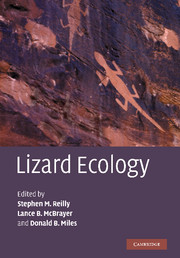Book contents
- Frontmatter
- Contents
- List of contributors
- Preface
- Historical introduction: on widely foraging for Kalahari lizards
- I Organismal patterns of variation with foraging mode
- 1 Movement patterns in lizards: measurement, modality, and behavioral correlates
- 2 Morphology, performance, and foraging mode
- 3 Physiological correlates of lizard foraging mode
- 4 Lizard energetics and the sit-and-wait vs. wide-foraging paradigm
- 5 Feeding ecology in the natural world
- 6 Why is intraspecific niche partitioning more common in snakes than in lizards?
- 7 Herbivory and foraging mode in lizards
- 8 Lizard chemical senses, chemosensory behavior, and foraging mode
- 9 Patterns of head shape variation in lizards: morphological correlates of foraging mode
- 10 Prey capture and prey processing behavior and the evolution of lingual and sensory characteristics: divergences and convergences in lizard feeding biology
- 11 The meaning and consequences of foraging mode in snakes
- II Environmental influences on foraging mode
- Index
- References
10 - Prey capture and prey processing behavior and the evolution of lingual and sensory characteristics: divergences and convergences in lizard feeding biology
Published online by Cambridge University Press: 04 August 2010
- Frontmatter
- Contents
- List of contributors
- Preface
- Historical introduction: on widely foraging for Kalahari lizards
- I Organismal patterns of variation with foraging mode
- 1 Movement patterns in lizards: measurement, modality, and behavioral correlates
- 2 Morphology, performance, and foraging mode
- 3 Physiological correlates of lizard foraging mode
- 4 Lizard energetics and the sit-and-wait vs. wide-foraging paradigm
- 5 Feeding ecology in the natural world
- 6 Why is intraspecific niche partitioning more common in snakes than in lizards?
- 7 Herbivory and foraging mode in lizards
- 8 Lizard chemical senses, chemosensory behavior, and foraging mode
- 9 Patterns of head shape variation in lizards: morphological correlates of foraging mode
- 10 Prey capture and prey processing behavior and the evolution of lingual and sensory characteristics: divergences and convergences in lizard feeding biology
- 11 The meaning and consequences of foraging mode in snakes
- II Environmental influences on foraging mode
- Index
- References
Summary
Introduction
Prey location, capture, and subsequent processing are fundamentally important behaviors critical to the assimilation of food resources. All three of these behaviors involve movements of the tongue and jaws and it is well known that both tongue movements and tongue morphology vary widely among lizards (Schwenk, 2000). A central element of the sit-and-wait (ambush) vs. wide foraging paradigm involves the trade-off between prey capture function and chemosensory acuity. In general, ambush feeders are thought to use the tongue primarily to capture prey located visually, whereas wide foragers are thought to have traded tongue-based prey capture for tongue-flicking, which is critical to locating widely dispersed prey by using chemoreception (Pianka and Vitt, 2003; Cooper, 1997a). The switch to chemosensory tongue function among scleroglossan lizards is certainly linked to their wide-foraging strategy; in fact, this transition has enabled wide foragers to dominate lizard communities worldwide (Vitt et al., 2003). In this chapter we examine the trade-off between feeding behaviors (prey capture and subsequent prey processing) and chemosensory function in lizards with data available to date. First, we present new data and a review of kinematic patterns of “prey capture” behaviors. This analysis illustrates three basic prey capture modes used by lizards. Next, we review patterns of post-capture prey processing behavior that reveal three evolutionary transitions in lizard “chewing” behavior. Finally, we compare changes in lizard feeding behavior with quantified characteristics of the vomeronasal system, tongue morphology, prey discrimination ability, and foraging behavior from the literature to examine how changes in feeding function correlate with changes in chemosensory function.
- Type
- Chapter
- Information
- Lizard Ecology , pp. 302 - 333Publisher: Cambridge University PressPrint publication year: 2007
References
- 23
- Cited by

